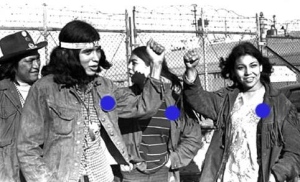In case you were wondering how and why a blue coloured dot has appeared on some famous First Nations photos that are in black and white, welcome to the Blue Dot movement.
The blue dot Internet meme has exploded on social media sites across the Internet as a status symbol – for the unwanted and uninvited.
Relations between Stephen Harper’s conservative government and First Nations, Metis and Inuit communities across Canada has been edgy, with a take-no-prisoner attitude all the way from communications from the Prime Minister’s Office (PMO) to right-wing trolls on the Internet who support his policies.
This is why the #IdleNoMore movement began in late November 2012, where Indigenous communities in North American and globally have used the language of round dances and blockades to communicate their intense hatred towards the government’s racist Indian Act policies.
For those of you who don’t remember, Idle No More began as a Twitter hashtag that, ‘them injuns ain’t gonna take it no more.”
The movement has had its share of growing pains, with internal divisions on the role of blockades to a not-well-thought-out plan to trademark the term Idle No More and assume some kind of ownership.
You can no more own a movement than you can own the wind.
The most recently manifestation of the fight for Indigenous rights has been the Blue Dot movement.
It stands specifically as a resistance to Harper’s First Nations Education Act (FNEA) and more informally as a statement for people to take notice of who is being included in the dialogue between the government and First Nations, Metis and Inuit communities and who is being purposely and systematically excluded.
The mandate of the FNEA is, “to provide support to First Nations who wish to exercise Jurisdiction over education. The FNEA will not have inherent jurisdiction and will only exercise jurisdiction in areas that have been delegated to it by Participating First Nations (PFNs).”
According to a press release by Grand Council Chief Patrick Madahbee on February 7, 2014, concerning the FNEA, he said, “As part of today’s announcement, Minister Valcourt stated that First Nations were extensively consulted across the country (which is not true). In addition, Minister Valcourt stated that the FNEA will not inhibit First Nation self-governance, but compliment self-government agreements. It should be noted that we have yet to see the federal government negotiate fairly when it comes to funding the Anishinabek Education System.
Because of the lack of honesty and cooperation coming from the Government of Canada in recent months, we have no reason to accept today’s announcement on face value. Therefore, my recommendation is that we continue on course of fighting legislation and/or policies that impede our progress on real FN control over FN education. We remain focused on protecting our children’s inherent rights to fair and equitable education.”
The proposed legislation was announced on the Kainai First Nation of the Blood Tribe Reserve in Alberta. Present at that announcement were Prime Minister Stephen Harper, Assembly of First Nations National Chief Shawn Atleo and Aboriginal Affairs Minister Bernard Valcourt. There, they even held a ceremony in the community to announce the policy.
Community member Twila Singer intended to attend the announcement but things did not go as planned for her and her two children that day.
According to Twila Singer, “We were separated at the door and given either a blue dot or a yellow dot. The blue dots were uninvited guests and were ushered to the gymnasium, and the invited guests were the yellow dots and they were brought to the auditorium where the dignitaries were.”
In this video, you can watch Singer eventually evicted from even the blue dot group.
Police later confirmed that she was removed for tweeting her disapproval at the meetings process, a charge she denied.
In response to Singer’s eviction and the overall segregation of the ‘supposedly good’ community members from the ‘bad’ or ‘potential troublemakers’, the Blue Dot movement was born.
Historical photos like this one of the American Indian Movement are showing up with blue dots. Christi Belcourt is using old photos of vocal figures to make a point with the blue dot campaign. (@christibelcourt/Twitter)
Toronto Indigenous activist, Patti Whabagoon Phipps-Walker, said, “the blue dot is for generation to come, for our children, our children’s children, etc. If we do not stand for them now who is to say what will happen. It is time to rise.”



